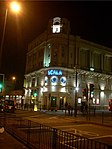Argyle Square

Argyle Square is a garden square in the London Borough of Camden in London, England. It is the main public park in Kings Cross. The square was built in the 1830s and 1840s, after the collapse of an attempt to build a music and arts centre in the area. Before its construction, the area was home to one of London's waste dumps. Almost all of the square remains in its original form, with numbers 7 to 47 (i.e. everything but the north side) Grade II-listed.It was the headquarters of the Swedenborgian movement in England, having been home to the New Jerusalem Church. However, the church was bombed in World War II, and later demolished as unsafe.Although originally built exclusively for residential properties (other than the church), the square is now home to a number of bed and breakfasts.
Excerpt from the Wikipedia article Argyle Square (License: CC BY-SA 3.0, Authors, Images).Argyle Square
Argyle Square, London King's Cross (London Borough of Camden)
Geographical coordinates (GPS) Address External links Nearby Places Show on map
Geographical coordinates (GPS)
| Latitude | Longitude |
|---|---|
| N 51.528888888889 ° | E -0.12222222222222 ° |
Address
Argyle Square
Argyle Square
WC1H 8AL London, King's Cross (London Borough of Camden)
England, United Kingdom
Open on Google Maps











